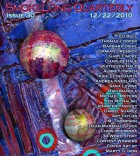You’ve written a vivid and elegant story based on Amelia Earhart. How did you get interested this famous aviator? What kind of research did you do in preparation for your story?
Historical and current events inspire much of my creative work, and you could say that exploring the line between fiction and non-fiction is an obsession of mine. I began reading about Amelia Earhart to distract myself from a longer project I’m working on and became fascinated by the mystery (and all the theories) surrounding her disappearance. Since fact in fiction doesn’t need to be airtight, my research process is very casual. I do all of my research from my living room
Does that mean you haven’t flown an airplane?
Haha. No. In fact I’m a really nervous flyer, so you definitely don’t want me behind the wheel, or stick, or whatever you fly an airplane with.
Well, you do good work behind the keyboard. I love the way you describe young Amelia’s trip off the farmhouse roof in a sled:
She spent a moment on the ramp, angled toward the clouds. Then a long beat in the air—flying! It was the same stomach dropping feeling as being at the top of her arc on the swing set, the moment when the chains go slack and you just fall. And then the hard smack of the ground. Her dress torn, her elbow bleeding, her molar turned to powder in her mouth.
Is that based on an actual event, or is it pure invention?
It’s a little bit of both. The moment is based on a true story, when a young Amelia and her uncle built a sort of mock roller coaster that began on the tool shed roof and ended in several scrapes and bruises. I altered it a bit to both simplify the situation and heighten the drama. Either way, it sounds like a recipe for death so I don’t recommend it.
That crushed molar reminds her of a nickname she dislikes: Meeley. Your story progresses through a series of names for the main character–Amy, Meeley, Mrs. Putnam, A.E., and, finally, Amelia–each of which attaches to an aspect of her identity. What, for you, is in a name?
When you call someone “Mr.” or “Dr.” or “Mom,” you imply something different with each mode of address. I think women, especially, are subject to being called by names that they don’t particularly like. It’s tough to feel like you have control over your destiny when you don’t even have control over your own name.
Amelia Earhart was a woman living in a man’s era and doing a man’s job. There are still people who contend that she wasn’t a very talented aviatrix, that she had to rely on the men around her to get a lot of the job done. While the frustration about the names is my invention, I tried to channel some of the frustration she must have felt in her time.
You say there are many theories explaining Amelia’s disappearance, and your story offers one. How did you arrive at this version of her fate?
As is often the case, when I started writing the story I didn’t know where it would go. I only knew that I wanted to give Amelia some agency within the context of her famous disappearance. The more I wrote, the more I realized how angry my Amelia was at almost everything around her. In the end I wanted her to decide to leave not only because of her anger, but also because she had a real sense of hope for a better life. A little romance with Fred Noonan, her navigator, seemed just the ticket.



 The core workshop of SmokeLong Fitness is all in writing, so you can take part from anywhere at anytime. We are excited about creating a supportive, consistent and structured environment for flash writers to work on their craft in a community. We are thrilled and proud to say that our workshop participants have won, placed, or been listed in every major flash competition. Community works.
The core workshop of SmokeLong Fitness is all in writing, so you can take part from anywhere at anytime. We are excited about creating a supportive, consistent and structured environment for flash writers to work on their craft in a community. We are thrilled and proud to say that our workshop participants have won, placed, or been listed in every major flash competition. Community works.